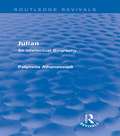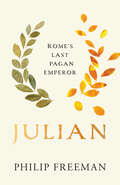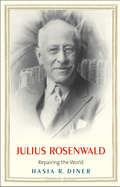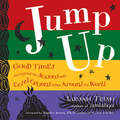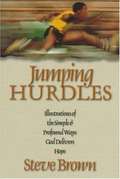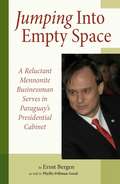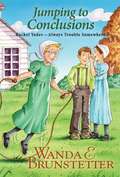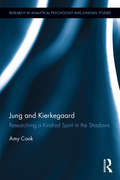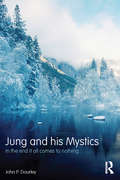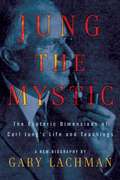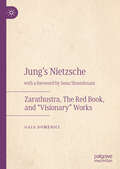- Table View
- List View
Julian of Norwich: Revelations of Divine Love
by Elizabeth Spearing Julian Of NorwichFrom the book: The showings were so compelling and so rich in meaning that Julian understood them to come directly from God and to be messages not just to herself but to all Christians. This led her to put them in writing and to convey her sense of their significance, as it was revealed in the course of many years of meditation, renewed by 'flashes of illumination and touches, I hope, of the same spirit which was shown in them all' (chapter 65). One supplementary showing came 'fifteen years and more later' - that is, about 1388 - and this she recounts in the final chapter of LT: [long text] it was that God's meaning in the whole series of experiences from 1373 was no more nor less than love. Julian wrote for private readers; they rather than listeners would have needed the list of contents in chapter 1 of LT and the summaries heading the other chapters (if these are authorial). Her target audience was initially 'all men and women who wish to lead the contemplative life' (ST [short text] chapter 4), but in LT she drops this limitation and seems to envisage a broader public of devout laypeople - a public that was on the increase in her lifetime. Since her work was adapted into modern English in 1901, her readership has expanded to far greater numbers than could have known it in earlier times. Both texts are included.
Julian's Cat: Imaginary History of a Cat of Destiny
by Mary E. LittleIn Norwich Cathedral there is a stained glass window depicting the great mystic, Julian of Norwich. In her hands she holds her book, Revelations of Divine Love, and at her feet sits possessively a regal cat the color of marmalade, staring boldly out at the world. Who was this mysterious feline who so endeared himself to Mother Julian, the author wondered. He must have a story . . . The pranks of the slightly naughty but lovable cat will charm pet lovers, the tale of the little child who first loved him will touch the heart, and the language and richness of detail will transport the reader through the pungent streets of medieval Norwich and into the lives of many colorful characters. Here is an enchanting adventure for Julian followers, anglophiles, and cat lovers of all ages.
Julian: An Intellectual Biography (Routledge Revivals)
by Polymnia AthanassiadiJulian: An Intellectual Biography, first published in 1981, presents a penetrating and scholarly analysis of Julian’s intellectual development against the background of philosophy and religion in the late Roman Empire. Professor Polymnia Athanassiadi tells the story of Julian’s transformation from a reclusive and scholarly adolescent into a capable general and an audacious social reformer. However, his character was fraught with a great many contradictions, tensions and inconsistencies: he could be sensitive and intelligent, but also uncontrollably spontaneous and subject to alternating fits of considerable self-pity and self-delusion. Athanassiadi traces the Emperor Julian’s responses to personal and public challenges, and dwells on the conflicts that each weighty choice imposed on him. This analysis of Julian’s character and of all the issues that confronted him as an emperor, intellectual and mystic is based largely on contemporary evidence, with particular emphasis on the extensive writings of the man himself.
Julian: Rome's Last Pagan Emperor (Ancient Lives)
by Philip FreemanThe tragic life of Julian, the last non-Christian emperor of Rome, by award-winning author Philip Freeman Flavius Claudius Julianus, or Julian the Apostate, ruled Rome as sole emperor for just a year and a half, from 361 to 363, but during that time he turned the world upside down. Although a nephew of Constantine the Great, the first Christian emperor of Rome, Julian fought to return Rome to the old gods who had led his ancestors to build their vast empire. As emperor, Julian set about reforming the administration, conquering new territories, and reviving ancient religions. He was scorned in his time for repudiating Christianity and demonized as an apostate for willfully rejecting Christ. Through the centuries, Julian has been viewed by many as a tragic figure who sought to save Rome from its enemies and the corrupting influence of Christianity. Christian writers and historians have seen Julian much differently: as a traitor to God and violent oppressor of Christians. Had Julian not been killed by a random Persian spear, he might well have changed all of history.
Julie
by Catherine MarshallJulie Wallace was only eighteen when her family moved to a flood- prone Pennsylvania town in 1934. Here her father, risking their life savings, took over a struggling newspaper, and Julie began fighting to fulfill her dreams. She found herself taking sides as battle lines were drawn between desperate steelworkers and the owners of the mills- and being torn as two young men divided her loyalty and her heart. Then a devastating catastrophe became the ultimate test of courage and commitment-and Julie's special strength would come from love.
Julius Caesar Literary Classics
by William ShakespeareJulius Caesar, the first of Shakespeare's Roman plays, dramatizes the life of Rome's great general-turned dictator, and chronicles the power struggle that occurred after his assassination. This classic tragedy demonstrates the suffering that is the inevitable result of human pride, deceit, and lust for power. Part of A Beka Book literature series for 10th grade
Julius Rosenwald: Repairing the World
by Hasia R. DinerThe portrait of a humble retail magnate whose visionary ideas about charitable giving transformed the practice of philanthropy in America and beyond Julius Rosenwald (1862–1932) rose from modest means as the son of a peddler to meteoric wealth at the helm of Sears, Roebuck. Yet his most important legacy stands not upon his business acumen but on the pioneering changes he introduced to the practice of philanthropy. While few now recall Rosenwald’s name—he refused to have it attached to the buildings, projects, or endowments he supported—his passionate support of Jewish and African American causes continues to influence lives to this day. This biography of Julius Rosenwald explores his attitudes toward his own wealth and his distinct ideas about philanthropy, positing an intimate connection between his Jewish consciousness and his involvement with African Americans. The book shines light on his belief in the importance of giving in the present to make an impact on the future, and on his encouragement of beneficiaries to become partners in community institutions and projects. Rosenwald emerges from the pages as a compassionate man whose generosity and wisdom transformed the practice of philanthropy itself.
Jump
by Efrem SmithJump is a powerful guide to becoming a vehicle of compassion, reconciliation, and transformation in our world.Life is all about jumps. We jump from high school to college, school to the professional world, dating to marriage. Each leap launches us to new levels. Even though we can't see what's on the other side of the wall, our faith jumps are about trusting that God is there. We experience the liberation when we jump into the arms of our Savior, then into a church family, and then into a world desperately in need.Efrem Smith presents fresh insights into how Christians can say yes to the jump that takes them deeper into a loving, devotional, intimate life with God.
Jump Off the Hormone Swing: Fly Through the Physical, Mental, and Spiritual Symptoms of PMS and Perimenopause
by Lorraine PintusIn Jump Off the Hormone Swing, Lorraine Pintus shares openly about the inner tension a woman can feel at certain times of the month between wanting to love her neighbor on one hand, and wanting to strangle her and shoot her ugly dog on the other. While many books discuss the physical and emotional symptoms of hormones, this is the first to explore in depth the spiritual aspects. Jump! is a mentoring book, not a medical book. The focus is on attitude, not anatomy. Lorraine shares insights from her own journey as well as wisdom from 1,500 women she surveyed. Sound biblical wisdom is laced with humor because after all, when it comes to hormones, you either have to laugh or cry, and laughing is better! Get answers to these questions: · What is the number one thing I can do to feel better physically? · How does PMS and perimenopause affect me spiritually? · Which foods ease PMS symptoms...which make them worse? · How do hormones affect my brain? · Why does stress make my PMS worse and what can I do about it? · Are there benefits to PMS and perimenopause? (you&’ll discover 10!!) · How can God possibly love me when I hate myself? Includes a 10-week study for individual and group use.
Jump Off the Hormone Swing: Fly Through the Physical, Mental, and Spiritual Symptoms of PMS and Perimenopause
by Lorraine PintusIn Jump Off the Hormone Swing, Lorraine Pintus shares openly about the inner tension a woman can feel at certain times of the month between wanting to love her neighbor on one hand, and wanting to strangle her and shoot her ugly dog on the other. While many books discuss the physical and emotional symptoms of hormones, this is the first to explore in depth the spiritual aspects. Jump! is a mentoring book, not a medical book. The focus is on attitude, not anatomy. Lorraine shares insights from her own journey as well as wisdom from 1,500 women she surveyed. Sound biblical wisdom is laced with humor because after all, when it comes to hormones, you either have to laugh or cry, and laughing is better! Get answers to these questions: · What is the number one thing I can do to feel better physically? · How does PMS and perimenopause affect me spiritually? · Which foods ease PMS symptoms...which make them worse? · How do hormones affect my brain? · Why does stress make my PMS worse and what can I do about it? · Are there benefits to PMS and perimenopause? (you&’ll discover 10!!) · How can God possibly love me when I hate myself? Includes a 10-week study for individual and group use.
Jump Up: Good Times throughout the Seasons with Celebrations from Around the World
by Luisah TeishVirtually all peoples of the world celebrate the passage of seasons. The continual movement of time through winter, spring, summer, and autumn has framed human experience and profoundly affected the lives of individuals and communities for many thousands of years.Celebrations that mark the seasons are rich with food, music, dance, offerings, and the reenactment of myth. Jump Up (titled after a Caribbean phrase that is used to describe a celebration) is meant to reacquaint readers with these traditions and to give them suggested practices for honoring past traditions in new ways.African traditions form the core of the book, and ceremonies and practices from Europe, Asia, the Americas, and the South Pacific are interwoven throughout. Readers will encounter the origin of well-known holidays and, at the same time, learn about others that are unknown in the Western world. Some of the more familiar cultural-based seasonal holidays that appear in this book include Christmas, New Year's Day, Mardi Gras, Palm Sunday, Easter, May Day, Day of the Dead, and the African American holiday of Kwaanza.Each season's story is accompanied by recipes, suggestions and guidelines for rituals to help readers create their own celebrations. One winter ritual, complete with instructions, is the Ritual of the Cleansing Fire, and an autumn ritual is the Building of the Autumn Equinox Altar. The recommended rituals are generic, and they can be done in conjunction with or in place of traditional holidays. Laced with myth, folklore, and poetry, Jump Up celebrates life, enlivens the spirit, and strengthens the bonds of community.
Jumping Hurdles: Illustrations of the Simple and Profound Ways God Delivers Hope
by Steve BrownIn Jumping Hurdles, Steve Brown illustrates with graceful realism how we are magnificently equipped to overcome the hurdles in our lives. 'If you listen between the lines of life's fine print, ' writes Steve Brown, 'you can hear God whispering, talking and sometimes shouting, 'I am here! All is well. ' God wants us to overcome life's challenges, and the best way is His way. ' The author mediates on everyday hurdles such as: Learning from Pain; Hearing God's Voice; Discovering Our Identity; Casting Off Our Burdens; and Overcoming Discouragement.
Jumping Into Empty Space: A Reluctant Mennonite Businessman Serves In Paraguay's Presidential Cabinet
by Ernst BergenErnst Bergen had good reason to say no when the President of his country asked him to join his cabinet. Massive corruption was considered the ordinary course of business in Paraguay and had driven it to near financial ruin. Bergen, at age 39, was among the most successful men in the country with not an ounce of interest in government politics. What's more, Bergen grew up in a Mennonite colony situated in the inhospitable wilderness of the Paraguayan Chaco. He belongs to a highly industrious religious people who, for reasons of history and theology, are acutely suspicious of being involved in government. Jumping Into Empty Space tells two stories: the beginning of a remarkable economic turn-around in a battered country at the hand of this fearless business strategist; and the emergence of a true leader, told with unusual honesty and wisdom. Not only did Bergen have his own hot temper to control, he had to face extraordinary special interests and decades of despair everywhere, including in the President's own party.Skyhorse Publishing, along with our Arcade, Good Books, Sports Publishing, and Yucca imprints, is proud to publish a broad range of biographies, autobiographies, and memoirs. Our list includes biographies on well-known historical figures like Benjamin Franklin, Nelson Mandela, and Alexander Graham Bell, as well as villains from history, such as Heinrich Himmler, John Wayne Gacy, and O. J. Simpson. We have also published survivor stories of World War II, memoirs about overcoming adversity, first-hand tales of adventure, and much more. While not every title we publish becomes a New York Times bestseller or a national bestseller, we are committed to books on subjects that are sometimes overlooked and to authors whose work might not otherwise find a home.
Jumping To Conclusions (Rachel Yoder, Always Trouble Somewhere Series Book #7)
by Wanda E. BrunstetterRachel's Back and This Time She's Jumping to Conclusions! Eleven-year-old Rachel Yoder encounters trouble at every turn with her Amish friends and family when she spreads unintentional rumors as a result of her eavesdropping. From a little misunderstanding about Cousin Mary moving back to town ... to a much bigger and out-of-control rumor about her brother Jacob's health, things go from bad to worse for Rachel. Will she ever learn that assumptions often have hurtful consequences?
Jumping in Sunset
by Dawn RinglingDivorce is not just a fact in Christian circles, it's a common occurrence. Yet most Christian fiction dealing with marital struggles insists that reconciliation is always possible. Jumping in Sunset shows how God's abundant love works through situations where the neat, accepted answers don't. Meet Pamela Thornton, who has a comfortable faith, a twenty-year marriage, and a solid relationship with her college-bound daughter - when her husband announces he's leaving her to marry another woman. Slowly, Pamela learns to understand and experience God within the impossible truth that her marriage has come to an end.
June Hunt Hope for the Heart Biblical Counseling Library
by June HuntSave over $40 when you buy all 36 June Hunt Hope for the Heart Biblical Counseling Library Minibooks. A $143 value for just $99.* Adultery: The Snare of an Affair* Alcohol and Drug Abuse: Breaking Free and Staying Free* Anger: Facing the Fire Within* Anorexia And Bulimia: Control That Is Out Of Control* Bullying: Bully No More* Codependency: Balancing an Unbalanced Relationship* Conflict Resolution: Solving Your People Problems* Confrontation: Challenging Others to Change* Considering Marriage: Are You Fit to Be Tied?* Decision Making: Discerning the Will of God* Depression: Emerging from Darkness into the Dawn* Domestic Violence: Assault on a Woman's Worth* Dyfunctional Family: Making Peace With Your Past* Fear: No Longer Afraid* Financial Freedom: How To Manage Money Wisely* Forgiveness: The Freedom to Let Go* Friendship: Iron Sharpening Iron* Gambling: Betting Your Life Away* Grief: Living at Peace with Loss* Guilt: Living Guilt-Free* Hope: The Anchor of Your Soul* Loneliness: How To Be Alone but Not Lonely* Manipulation: Cutting the Strings of Control* Marriage: To Have and To Hold* Parenting: Steps to Successful Parenting* Perfectionism: The Performance Trap* Overeating: Freedom From Food Fixation* Reconciliation: Restoring Broken Relationships* Rejection: Healing a Wounded Heart* Self-Worth: Discover Your God-Given Worth* Sexual Integrity: Balancing Your Passion with Purity* Singleness: How to be Single & Satisfied* Stress: How to Cope at the End of Your Rope* Success through Failure* Suicide Prevention: Hope When Life Seems Hopeless* Verbal and Emotional Abuse: Victory over Verbal and Emotional Abuse
Jung and Christianity: The Challenge of Reconciliation
by Wallace B. CliftA parish minister attempts to answer the challenge presented to Christianity in the last decade of Jung's life--to make the teachings real in this day and age, and offer true enlightenment of the soul.
Jung and Feminism: Liberating Archetypes (Psychology Revivals)
by Demaris S. WehrJung, in contrast to Freud, has typically been considered more sympathetic to women largely because of his emphasis on the feminine as a way of being in the world and on the ‘anima’, the unconscious feminine aspect of male personality. Feminists, however, have viewed Jung’s whole notion of the ‘feminine’ with suspicion, seeing it as a projection of male psyche and not an authentic understanding of female humanity. For Demaris Wehr both feminism and Jungian psychology have been guiding forces, and in this book, originally published in 1988, she mediates between feminists and classical Jungians – two groups historically at odds. She faces squarely the male-centred assumptions of some Jungian concepts and challenges Jung’s claims for the universality and purely empirical basis of his work, but nevertheless maintains an appreciation for the value of Jung’s understanding of human nature and the process of individuation. By bringing the insights of feminist theology to bear on the seemingly unbridgeable gap between analytical psychology and feminism, she succeeds in reclaiming Jungian psychology as a freeing therapy for women and reveals it as the ultimately liberating vision its founder intended it to be.
Jung and Kierkegaard: Researching a Kindred Spirit in the Shadows (Research in Analytical Psychology and Jungian Studies)
by Amy CookJung and Kierkegaard identifies authenticity, suffering and self-deception as the three key themes that connect the work of Carl Jung and Søren Kierkegaard. There is, in the thinking of these pioneering psychologists of the human condition, a fundamental belief in the healing potential of a religious outlook. This engaging and erudite text explores the significance of the similarities of thinking between Kierkegaard and Jung, bridging the gap between the former’s particular brand of existential Christian psychology and the latter’s own unique philosophy. Given the similarity of their work and experiences that were common to both of their personal biographies, particularly the relationship that each had with his father, one might expect Jung to have found in Kierkegaard a kindred spirit. Yet this was not the case, and Jung viewed Kierkegaard with great scorn. That there exists such a strong comparison and extensive overlap in the life and thought of these towering figures of psychology and philosophy leads us to question why it is that Jung so strongly rejected Kierkegaard. Such hostility is particularly fascinating given the striking similarity that Jung’s own analytical psychology bears to the Christian psychology upheld by Kierkegaard. Cook’s thought-provoking book fills a very real gap in Jungian scholarship and is the first attempt to undertake a direct comparison between Jung and Kierkegaard’s models of development. It is therefore essential reading for academics and postgraduate students with an interest in Jungian and Kierkegaard scholarship, as well as psychology, philosophy and religion more generally.
Jung and his Mystics: In the end it all comes to nothing
by John P. DourleyJung’s psychology describes the origin of the Gods and their religions in terms of the impact of archetypal powers on consciousness. For Jung this impact is the basis of the numinous, the experience of the divine in nature and in human nature. His psychology, while possessed of a certain claim to science, is based on depths of subjective experience which transcends psychology and science as ordinarily understood. Jung and his Mystics: In the end it all comes to nothing examines the mythic nature of Jung’s psychology and thought, and demonstrates the influence of mysticism and certain religious thinkers in formulating his own work. John P. Dourley explores the influence of Mechthild of Magdeburg and fellow mystics/Beguines, and traces the mystic impulse and its expression through Meister Eckhat and Jacob Boehme to Hegel in the nineteenth century. All of these mystics were of the apophatic school and understood the culmination of their experience to lie in an identity with divinity in a nothingness beyond all form, formal expression or immediate activity. Dourley shows how this is still of relevance in our lives today. The book concludes that Jung’s understanding of mysticism could greatly alleviate the conflict between faiths, religious or political, by drawing attention to their common origin in the depths of the human. Jung and his Mystics: In the end it all comes to nothing is aimed at scholars and senior research students in Jungian Studies, including religionists, theologians and philosophers of religion, especially those with an interest in mysticism. It will also be essential reading for those interested in the connection between religious and psychological experience.
Jung and the Jungians on Myth: An Introduction (Theorists of Myth #Vol. 4)
by Steven WalkerFirst Published in 2002. Routledge is an imprint of Taylor & Francis, an informa company.
Jung on Ignatius of Loyola’s Spiritual Exercises: Lectures Delivered at ETH Zurich, Volume 7: 1939–1940 (Philemon Foundation Series #27)
by C. G. JungJung&’s lectures on the psychology of Jesuit spiritual practice—unabridged in English for the first timeBetween 1933 and 1941, C. G. Jung delivered a series of public lectures at the Swiss Federal Institute of Technology (ETH) in Zurich. Intended for a general audience, these lectures addressed a broad range of topics, from yoga and meditation to dream analysis and the psychology of alchemy. Here for the first time are Jung&’s complete lectures on Ignatius of Loyola&’s Spiritual Exercises, delivered in the winter of 1939–1940.These illuminating lectures are the culmination of Jung&’s investigation into traditional forms of meditation and their parallels to his psychotherapeutic method of active imagination. Jung presents Loyola&’s exercises as the prime example of a Christian practice comparable to yoga and Eastern meditation, and gives a psychological interpretation of the visions depicted in the saint&’s autobiographical writings. Offering a unique opportunity to encounter the brilliant psychologist as he shares his ideas with the general public, the lectures reflect Jung&’s increasingly positive engagement with Roman Catholicism, a development that would lead to his fruitful collaborations after the war with eminent Catholic theologians such as Victor White, Bruno de Jésus-Marie, and Hugo Rahner.Featuring an authoritative introduction by Martin Liebscher along with explanations of Jungian concepts and psychological terminology, this splendid book provides an invaluable window on the evolution of Jung&’s thought and a vital key to understanding his later work.
Jung the Mystic
by Gary LachmanNow in paperback, this bold new biography fills a gap in our understanding of the pioneering psychologist by focusing on the occult and mystical aspects of Jung’s thought and career. “Outstanding . . . lifts the curtain on one of the most important aspects of his remarkable life . . . fair and objective. ” —Alice O. Howell, Quest magazine “How the Swiss psychologist lived a life rich in the paranormal. ” —Los Angeles Times “A serious but comprehensible new biography of Jung and his interest in the esoteric. ” —New Age Retailer “Fascinating . . . Fully engaging from beginning to end. ” —Dell Horoscope Although he is often called the “founding father of the New Age,” Carl Jung, the legendary Swiss psychiatrist best known for his groundbreaking concepts such as the collective unconscious, archetype theory, and synchronicity, often took pains to avoid any explicit association with mysticism or the occult. Yet Jung lived a life rich in paranormal experiences—arguing for the existence of poltergeists in a debate with Sigmund Freud, participating in séances, incorporating astrology into his therapeutic work, reporting a near-death experience, and analyzing the work of pioneering ESP researcher J. B. Rhine. It is these critical experiences—often fleetingly touched on in other biographies or critical studies, and frequently used to make a case against Jung and his philosophies—that form the core of this significant new biography. .
Jung's Ethics: Moral Psychology and his Cure of Souls (Philosophy and Psychoanalysis)
by Dan MerkurThis volume presents the first organized study of Jung's ethics. Drawing on direct quotes from all of his collected works, interviews, and seminars, psychoanalyst and religious scholar Dan Merkur provides a compendium of Jung’s thoughts on various topics and themes that comprise his theoretical corpus—from the personal unconscious, repression, dreams, good and evil, and the shadow, to collective phenomena such as the archetypes, synchronicity, the psychoid, the paranormal, God, and the Self, as well as his contributions to clinical method and technique including active imagination, inner dialogue, and the process of individuation and consciousness expansion. The interconnecting thread in Merkur's approach to the subject matter is to read Jung’s work through an ethical lens. What comes to light is how Merkur systematically portrays Jung as a moralist, but also as a complex thinker who situates the human being as an instinctual animal struggling with internal conflict and naturalized sin. Merkur exposes the tension and development in Jung’s thinking by exploring his innovative clinical-technical methods and experimentation, such as through active imagination, inner dialogue, and expressive therapies, hence underscoring unconscious creativity in dreaming, symbol formation, engaging the paranormal, and artistic productions leading to expansions of consciousness, which becomes a necessary part of individuation or the working through process in pursuit of self-actualization and wholeness. In the end, we are offered a unique presentation of Jung’s core theoretical and clinical ideas centering on an ethical fulcrum, whereby his moral psychology leads to a cure of souls. Jung’s Ethics will be of interest to academics, scholars, researchers, and practitioners in the fields of Jungian studies and analytical psychology, ethics, moral psychology, philosophy, religious studies, and mental health professionals focusing on the integration of humanities and psychoanalysis.
Jung's Nietzsche: Zarathustra, The Red Book, and “Visionary” Works
by Gaia DomeniciThis book explores C.G. Jung's complex relationship with Friedrich Nietzsche through the lens of the so-called 'visionary' literary tradition. The book connects Jung's experience of the posthumously published Liber Novus (The Red Book) with his own (mis)understanding of Nietzsche's Zarathustra, and formulates the hypothesis of Jung considering Zarathustra as Nietzsche's Liber Novus –– both works being regarded by Jung as 'visionary' experiences. After exploring some 'visionary' authors often compared by Jung to Nietzsche (Goethe, Hölderlin, Spitteler, F. T. Vischer), the book focuses upon Nietzsche and Jung exclusively. It analyses stylistic similarities, as well as explicit references to Nietzsche and Zarathustra in Liber Novus, drawing on Jung's annotations in his own copy of Zarathustra. The book then uses Liber Novus as a prism to contextualize and understand Jung's five-year seminar on Zarathustra: all the nuances of Jung's interpretation of Zarathustra can be fully explained, only when compared with Liber Novus and its symbology. One of the main topics of the book concerns the figure of 'Christ' and Nietzsche's and Jung's understandings of the 'death of God.'


